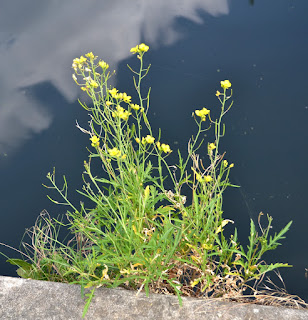7
August 2015
All day
This walk not only
allowed us to see a variety of sites of botanical interest, but also to
contrast the friendly present-day multicultural community of, particularly,
Turks and Jews, with surviving signs of an industrial and even agricultural
past.
We started from
Cambridge Heath station at Bethnal Green and walked north up the main road to
the Regents Canal Andrews Road London
At the corner of Andrews
Road was a work "Based on a True Story" by Zabou, who came as a
French art student to London, now lives and works as a designer here, but still
continues with her nocturnal creations, this one in collaboration with Sr.X
from Spain.
By the side of the
canal we immediately started recording the (mostly alien) plants expected at
such a site: buddleia Buddleja davidii,
petty spurge Euphorbia peplus, shaggy
soldier Galinsoga quadriradiata,
yellow corydalis Pseudofumaria lutea,
Guernsey & Bilbao's fleabanes Conyza
sumatrensis &floribunda, red
valerian Centranthus ruber, hollyhock
Alcea rosea, haresfoot clover Trifolium arvense, wall barley Hordeum murale, gypsywort Leucopus europaeus, annual mercury Mercurialis annua and black horehound Ballota nigra. In the canal were greater, common and least
duckweeds - Spirodela polyrhiza, Lemna minor, L. minuta.
On Andrews Road
Nineteenth century
ironworks, Andrews Road
Beyond here,
across the canal, was a more recent relic that is no longer used and is about
to be converted into new housing - the empty framework of 20th century
gasometers.
From opposite
these gasometers we walked north as far as Westgate Street, on the other side
of which lay London Fields, even its name redolent of the long gone
agricultural past of this area. It is
now a park and as we entered we passed a flowering tree of walnut Juglans regia.
But the past is
not forgotten, as several constructions here made by Freeform, a community arts
group, in collaboration with local schools, provided mosaic seats among
memorials to the old flower-sellers and sheep, for this was once where an
ancient drove road came and flocks were rested before going on the final lap to
the market. The bowler hats of the
flower women give them the appearance of Peruvian Incas, an exotic touch
congruent with the community.
A large part of
the park has been devoted to creating an "urban meadow" by scattering
a wild flower mix (almost all alien flowers) on bare, somewhat sandy,
ground. By now it was past its best but
there was still plenty of colour here and there, and a bewildering variety of
plants. We were able to recognise sweet
alison Lobularia maritima, common
poppy Papaver rhoeas, California
poppy Eschscholzia californica,
cornflower Centaurea cyanus, Virginia
stock Malcolmia maritima, Clarkia cv, purple viper's bugloss Echium plantagineum (incl. 'Alba'),
prostrate toadflax Linaria supina, Linaria maroccana, Cosmos bipinnatus cv's, Dahlia
'Star'cv, Echinacea angustifolia;
plus several that presumably came in of their own accord - marsh yellow-cress Rorippa palustris, false London-rocket Sisymbrium loeselii, common orache Atriplex patula and scentless mayweed Tripleurospermum inodorum.
Purple viper's bugloss
The colourful meadow seems
symbolic of the ethnic mix of the surrounding community
Echium
plantagineum
'Alba'
Cosmos
bipinnatus
Dahlia 'Star' cv.
Echinacea
angustifolia
cv.
Cornflower
Linaria
maroccana
As is usual in London parks the older trees are dominated by London
Plane trees, London Fields
From the north end
of the park we walked across Mare
Street
Horse-chestnuts along
Churchwell Path
At the end we
continued north along Lower
Clapton Road Lea Bridge Road Lea Navigation
Canal Lee Valley
Park
"Nature's
Throne"
The vegetation, in
and out of the water, is dominated by rough wasteland plants and of little
interest botanically, although there are large stands of giant hogweed Heracleum mantegazzianum and some large
trees of fruiting fig Ficus carica.
Giant hogweed
Fig
Other plants here
worth mentioning are Turkey oak Quercus
cerris, Canadian goldenrod Solidago
canadensis, hairy Michaelmas-daisy Aster
novae-angliae, common spike-rush Eleocharis
palustris, perennial wall-rocket Diplotaxis
tenuifolia, water bent Polypogon
viridis and the alien subspecies of black nightshade Solanum nigrum schultzii.
We returned to the Lea Bridge and
across the road was a Park, North Middlefields, where there was another expanse
of sown "urban meadow", including quite a few species not seen at
London Fields, such as corn marigold Glebionis
segetum, chamomile Chamaemelum nobile,
Linum grandiflorum and Italian
catchfly Silene italica (pink and
white forms).
Chamomile
|
Linum grandiflorum
|
Italian catchfly
|
A path beside the
park and the Lea Navigation took us north a little way until we could return
west along Mount Pleasant Hill
Lea Navigation passing Essex Filter-beds
Common skullcap
Perennial wall-rocket
Dense patch of floating
pennywort
We had a long trek
up Mount Pleasant
Hill , passing a young fig growing in wasteland, and along Northwold Road Abney Park Cemetery Abney Park
Hollow ash Fraxinus excelsior near the entrance
Pollarded black Italian poplar
Populus x canadensis 'Serotina'
Old hawthorn Crataegus monogyna
Rare bracket fungus Phylloporia ribis at base of the old
hawthorn
Jumbled graves and old
hornbeam Carpinus betulus (left of
centre)
"One-legged" ash
- it is still living!
Sorbus
latifolia
(Service tree of Fontainebleau
Spotted thorn Crataegus punctatus
Fruit and leaves of
spotted thorn. Spots (lenticels) on the haws give it its name.
Leaf near the haws has a
mine of the moth Stigmella oxyacanthella.
The ground flora
of Abney Park London
To complete our multicultural
experience we walked south down Kingsland
High Street Arcola Street




































No comments:
Post a Comment